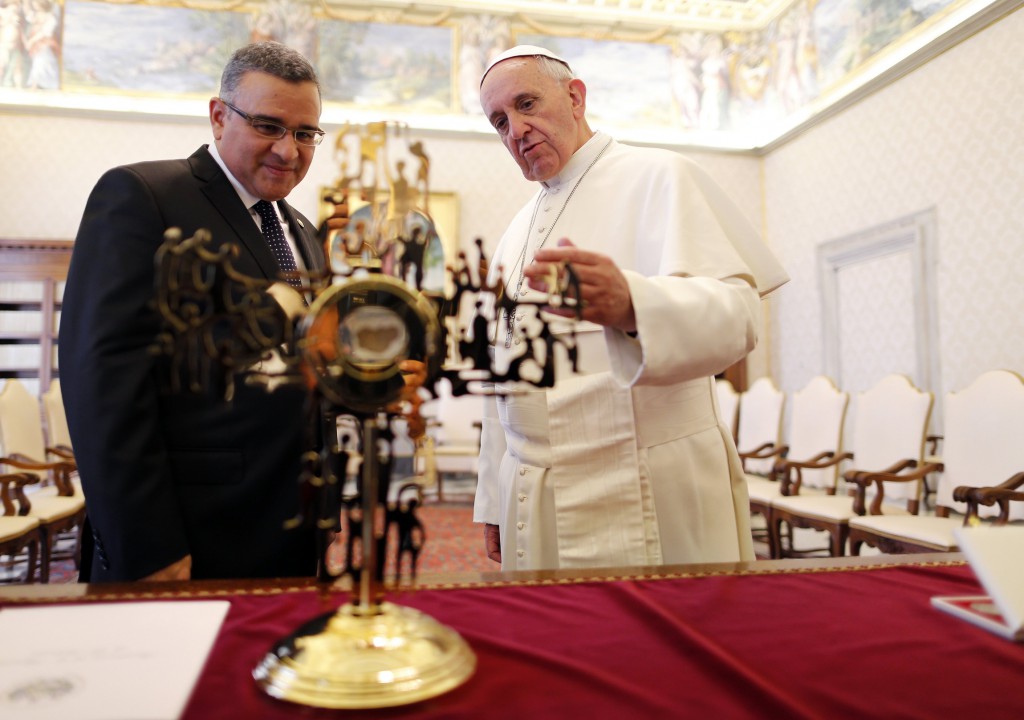
By Carol Glatz
Pope Francis received a bloodstained relic of slain Archbishop Oscar Romero as a gift from El Salvador’s President Mauricio Funes Cartagena.
Funes had told the media before his May 23 trip that the primary aim of his visit with the pope would be to express his gratitude that the archbishop’s canonization process had been “unblocked” and to encourage the sainthood process move forward.
The Vatican said the pope and Funes talked about Archbishop Romero and “the importance of his witness for the whole nation” of El Salvador.
The two leaders also talked about the church’s work in fostering peace and reconciliation; providing education and charity, and in fighting poverty and organized crime, the Vatican said in a written statement.
“The defense of human life, marriage and the family” was also discussed, it said.
Upon meeting the pope outside the papal library, Funes told the pontiff he was “very honored” to be there. “Many thanks for receiving me and thank you very much for this audience,” the president told the Argentine pope.
Pope Francis and Funes then spoke privately for 12 minutes, followed by an exchange of gifts.
Funes presented the pope with a large gold-colored reliquary containing a faded white bloodstained piece of the vestment Archbishop Romero of San Salvador was wearing when he was gunned down March 24, 1980, while celebrating Mass in a hospital chapel.
Jesuit Father Federico Lombardi, Vatican spokesman, told reporters that there was “clearly a bloodstain” in the middle of the cloth.
The reliquary was a gift from the sisters of the Congregation of Missionary Carmelites of St. Theresa who run the Divine Providence Hospital where the archbishop had lived and was killed.
The engraving on the reliquary said in Spanish: “Monsignor Oscar Romero, Spiritual Guide of El Salvador.”
The president’s visit came one month after Italian Archbishop Vincenzo Paglia, the postulator for the archbishop’s sainthood cause, said the process to beatify and eventually canonize the slain Salvadoran archbishop has been unblocked.
The Congregation for Saints’ Causes authorized the opening of his cause in 1993, but many people working for Archbishop Romero’s cause described the congregation’s standard review of the candidate’s writings as being “blocked” from 2000 to 2005.
Pope Benedict XVI told reporters in 2007 that the archbishop was “certainly a great witness of the faith” who “merits beatification, I do not doubt.” However, he said even though work on the sainthood cause was proceeding, problems had been created when some groups unjustly tried to co-opt Archbishop Romero as a political figure.
El Salvador’s ambassador to the Holy See, Manuel Lopez, told The Associated Press before the May 23 meeting that when he greeted Pope Francis along with other diplomats March 22, the Latin American pope told him: “‘I hope that under this pontificate we can beatify him.'”
Msgr. Jesus Delgado Acevedo, who worked with Archbishop Romero and is now vicar general of the Archdiocese of San Salvador, told reporters recently that when he spoke with the future pope in 2007, then-Cardinal Jorge Mario Bergoglio told him that if he were the pope, the beatification and canonization of the slain archbishop would the first thing he would pursue.
Msgr. Delgado said that during another meeting in 2010, then-Cardinal Bergoglio recalled what he said about Archbishop Romero in 2007, but added that the problem was that he would never become pope because he was too old.
Father Lombardi told reporters after the president’s meeting with the pope that Archbishop Romero’s “cause is going forward in the Congregation for Saints’ Causes, according to church rules” and that it is solely up to the congregation “to inform us” about the status of the process.
The next step in the process is a formal papal declaration that Archbishop Romero died a martyr — that he was killed because of his faith. A miracle is not needed for the beatification of a martyr. – CNS